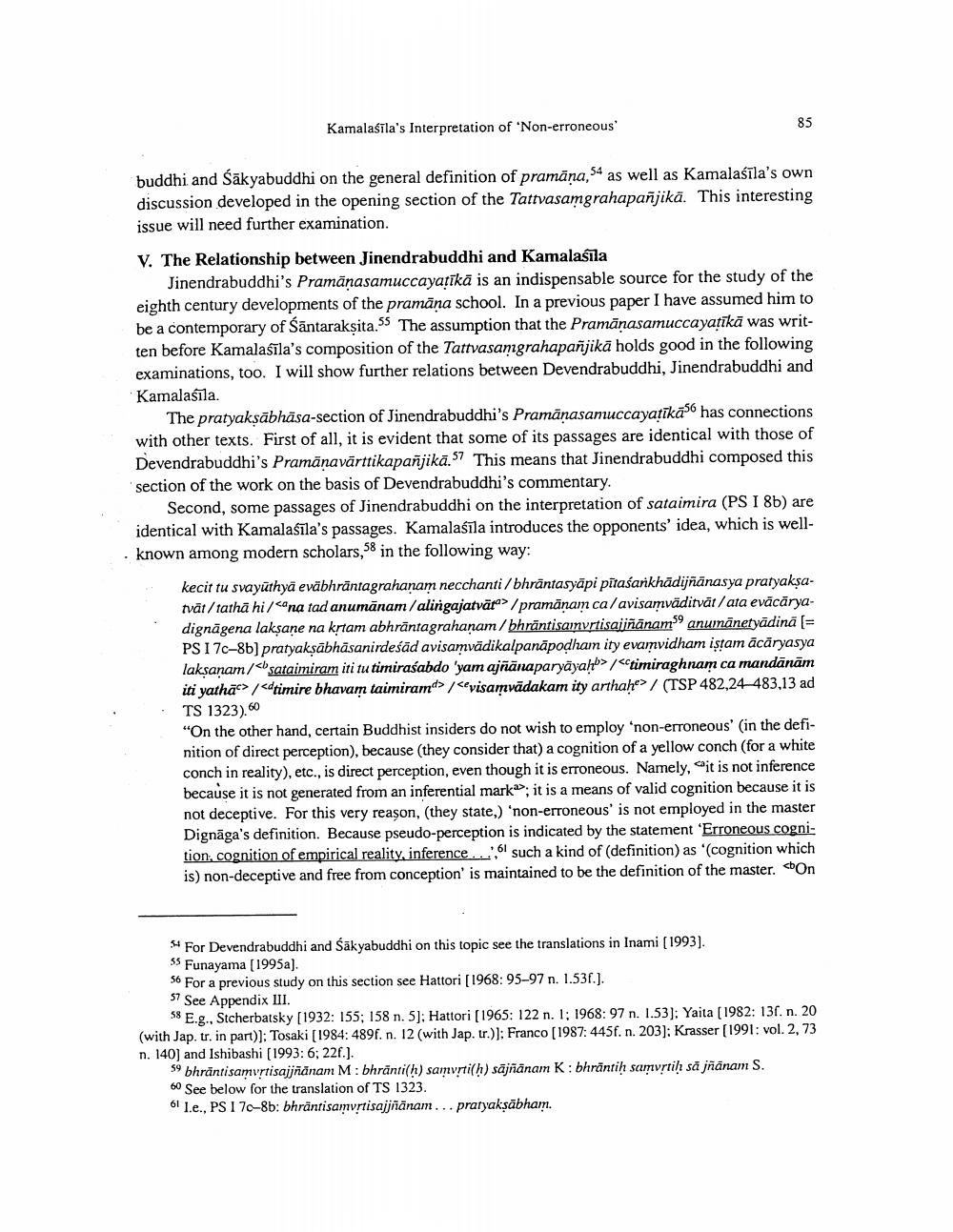________________
Kamalaśīla's Interpretation of 'Non-erroneous'
buddhi and Sakyabuddhi on the general definition of pramāna,54 as well as Kamalaśīla's own discussion developed in the opening section of the Tattvasamgrahapanjika. This interesting issue will need further examination.
V. The Relationship between Jinendrabuddhi and Kamalasīla
Jinendrabuddhi's Pramāṇasamuccayaṭīkā is an indispensable source for the study of the eighth century developments of the pramāna school. In a previous paper I have assumed him to be a contemporary of Santarakṣita.55 The assumption that the Pramanasamuccayaṭīkā was written before Kamalaŝīla's composition of the Tattvasamgrahapanjikā holds good in the following examinations, too. I will show further relations between Devendrabuddhi, Jinendrabuddhi and Kamalasila.
85
The pratyakṣābhasa-section of Jinendrabuddhi's Pramāṇasamuccayatīka56 has connections with other texts. First of all, it is evident that some of its passages are identical with those of Devendrabuddhi's Pramanavarttikapañjikā." This means that Jinendrabuddhi composed this section of the work on the basis of Devendrabuddhi's commentary.
Second, some passages of Jinendrabuddhi on the interpretation of sataimira (PS I 8b) are identical with Kamalasīla's passages. Kamalaśīla introduces the opponents' idea, which is wellknown among modern scholars, 58 in the following way:
kecit tu svayuthyä eväbhrāntagrahanam necchanti/bhrāntasyāpi pītaśankhādijñānasya pratyakṣatvät/tathā hi/<na tad anumanam/alingajatvata/pramānam ca/avisamvaditvät/ata evācāryadignāgena lakṣane na kṛtam abhrāntagrahanam/bhräntisamvṛtisajjñānam59 anumānetyādinā [= PS I 7c-8b] pratyakṣābhāsanirdeśad avisamvadikalpanapodham ity evamvidham iṣṭam ācāryasya lakṣaṇam/sataimiram iti tu timiraśabdo 'yam ajñānaparyayaḥ>/<timiraghnam ca mandānām iti yatha">/<dtimire bhavam taimiramd>/<evisamvadakam ity arthaḥ>/ (TSP 482,24-483,13 ad TS 1323),60
"On the other hand, certain Buddhist insiders do not wish to employ 'non-erroneous' (in the definition of direct perception), because (they consider that) a cognition of a yellow conch (for a white conch in reality), etc., is direct perception, even though it is erroneous. Namely, it is not inference because it is not generated from an inferential mark>; it is a means of valid cognition because it is not deceptive. For this very reason, (they state,) 'non-erroneous' is not employed in the master Dignaga's definition. Because pseudo-perception is indicated by the statement 'Erroneous cognition, cognition of empirical reality, inference....61 such a kind of (definition) as '(cognition which is) non-deceptive and free from conception' is maintained to be the definition of the master. <On
54 For Devendrabuddhi and Śakyabuddhi on this topic see the translations in Inami [1993].
55 Funayama [1995a].
56 For a previous study on this section see Hattori [1968: 95-97 n. 1.53f.].
57 See Appendix III.
58
E.g., Stcherbatsky [1932: 155; 158 n. 5]; Hattori [1965: 122 n. 1; 1968: 97 n. 1.53]; Yaita [1982: 13f. n. 20 (with Jap. tr. in part)]: Tosaki [1984: 489f. n. 12 (with Jap. tr.)]; Franco [1987: 445f. n. 203]; Krasser [1991: vol. 2, 73
n. 140] and Ishibashi [1993: 6; 22f.].
59 bhräntisamvṛtisajjñānam M: bhrānti(h) samvṛti(h) säjñānam K: bhräntiḥ samvṛtiḥ så jñānam S. 60 See below for the translation of TS 1323.
61 I.e., PS 17c-8b: bhräntisamvṛtisajjñānam... pratyakṣābham.




